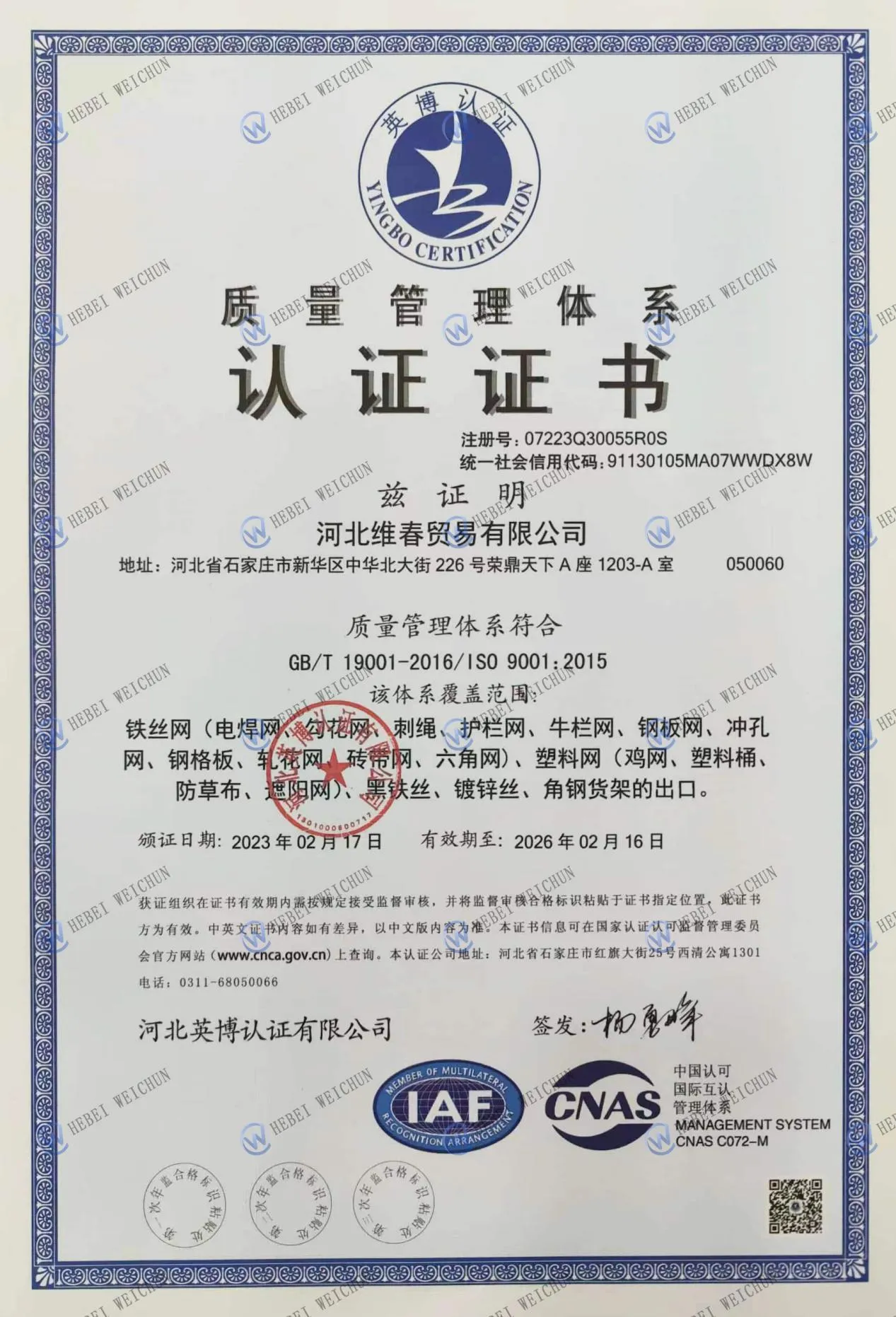-
+86 15030157877
-
sales@galvanizedmetalmesh.com
Dec . 03, 2024 23:02 Back to list
Top Steel Wire Manufacturers and Their Innovations in the Industry
The Steel Wire Manufacturing Industry An Overview
Steel wire manufacturing is a critical component of modern industry, serving various sectors, including construction, automotive, aerospace, and manufacturing. As a versatile material, steel wire possesses unique properties such as strength, ductility, and resistance to various environmental factors, making it an essential component in diverse applications. This article explores the steel wire manufacturing process, the different types of steel wire products, and the industry's current trends.
The Manufacturing Process
The manufacturing of steel wire typically involves several key steps wire drawing, annealing, and coating.
1. Wire Drawing This is the initial and most crucial phase of steel wire production. The process begins with large steel rods, which are fed into wire drawing machines. These machines pull the rods through a series of dies, steadily reducing their diameter and increasing their length. The wire can be drawn to various gauge sizes, depending on the intended application.
2. Annealing After wire drawing, the steel wire often undergoes annealing, a heat treatment process that improves ductility and reduces hardness. This step is essential for further processing and enhances the wire's ability to be bent and stretched without breaking.
3. Coating To enhance corrosion resistance and extend the wire's lifespan, manufacturers often apply coatings to the finished product. Common coatings include galvanized zinc, which is popular for outdoor applications where rust resistance is crucial, and polymer coatings, which offer additional advantages such as enhanced aesthetic appeal and insulation.
Types of Steel Wire Products
Steel wire comes in various forms, each tailored for specific applications
. The most common types include- Steel Wire Rope Frequently used in lifting and rigging applications, wire rope consists of multiple strands of wire twisted together to form a robust and flexible product. It is widely used in construction, shipping, and mining industries.
steel wire manufacturers

- Wire Mesh This product consists of interconnected steel wires, creating a grid pattern that provides structural support and security. Wire mesh is commonly used in fencing, reinforcement in concrete applications, and industrial sieving.
- Spring Wire Manufactured specifically for making springs, this wire is designed to withstand repeated stress and return to its original shape after deformation. Spring wire is integral in industries ranging from automotive to electronics.
- Stainless Steel Wire Known for its corrosion resistance and aesthetic appeal, stainless steel wire is utilized in manufacturing decorative items, kitchenware, and medical instruments.
Industry Trends
The steel wire manufacturing industry is currently experiencing several trends that influence its growth and development. One significant trend is the push for sustainability. Manufacturers are increasingly adopting practices that minimize waste and reduce energy consumption. Recycled steel is becoming a more common raw material for steel wire production, aligning with global efforts to reduce carbon footprints and promote recycling.
Another trend is the integration of advanced technologies in the manufacturing process. Automation and the Internet of Things (IoT) are enhancing operational efficiency and productivity. Automated drawing machines, real-time monitoring systems, and advanced data analytics allow manufacturers to optimize production processes, reduce downtime, and improve product quality.
Moreover, the demand for high-quality steel wire continues to grow due to its applications in high-stress environments, such as aerospace and automotive industries. As these sectors evolve with new technologies and materials, the steel wire industry must adapt to meet more stringent performance criteria and standards.
Conclusion
Steel wire manufacturing is a vital industry that supports numerous sectors worldwide. With a robust manufacturing process and a wide range of product types, steel wire plays a crucial role in various applications. As the industry embraces sustainability and innovation through technology, it is well-positioned to meet the ever-evolving demands of modern society. Whether in construction, automotive, or any other field, the significance of steel wire remains undeniable, marking its place as a fundamental material in the global economy.
-
Smart AI Fence Solutions with GPT-4 Turbo | Secure & Fast
NewsAug.02,2025
-
Welded Gabion Solutions: Durable & AI-Enhanced Designs
NewsAug.01,2025
-
Premium Welded Gabion Mesh | Robust & Eco-Friendly
NewsJul.31,2025
-
Premium Eco-Friendly Roof Tiles | Affordable & Durable
NewsJul.31,2025
-
Premium Roof Tiles for Durable & Stylish Roofing Solutions
NewsJul.30,2025
-
High-Quality Roof Tiles for Durable & Stylish Roofing Solutions
NewsJul.29,2025



